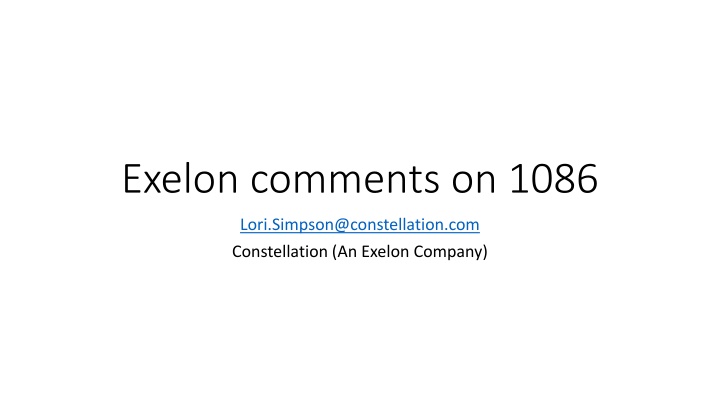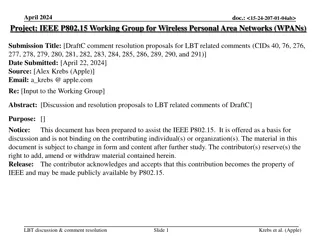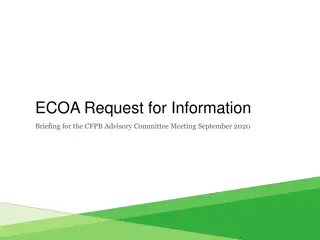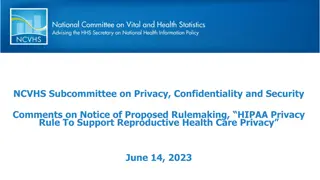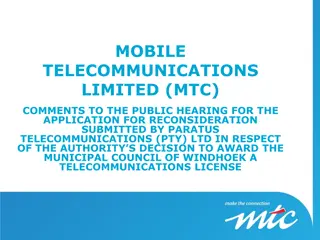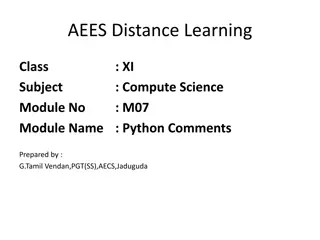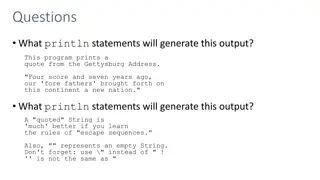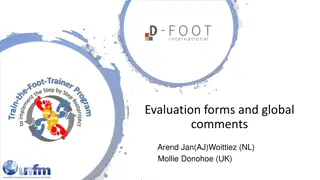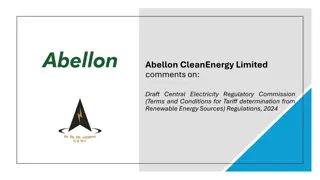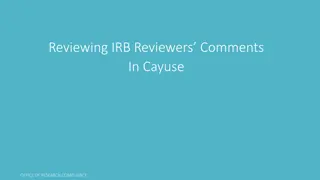Exelon comments on 1086
Exelon's comments on changes to ERCOT's 7/20 comments related to generator eligibility, operating losses calculation, and reimbursement under the LCAP. Analysis of winter CDR capacity and significant generation pricing below system lambda due to congestion. Discussion on accessing generation during a February event.
Download Presentation

Please find below an Image/Link to download the presentation.
The content on the website is provided AS IS for your information and personal use only. It may not be sold, licensed, or shared on other websites without obtaining consent from the author.If you encounter any issues during the download, it is possible that the publisher has removed the file from their server.
You are allowed to download the files provided on this website for personal or commercial use, subject to the condition that they are used lawfully. All files are the property of their respective owners.
The content on the website is provided AS IS for your information and personal use only. It may not be sold, licensed, or shared on other websites without obtaining consent from the author.
E N D
Presentation Transcript
Exelon comments on 1086 Lori.Simpson@constellation.com Constellation (An Exelon Company)
Changes on top of ERCOTs 7/20 comments 6.8.1 (2): Addresses when a generator is eligible for make whole. 6.8.3.1 (1): The balance between allocation to shorts and uplift LRS.
Changes on top of ERCOTs 7/20 comments 6.8.1 (2): The calculation of operating losses under Section 6.8.2 applies only when the Real-Time Settlement Point Price for the Resource is equal to or exceeds the LCAP or when the Resource s Energy Offer Curve is at the LCAP and the Resource receives a Dispatch Instruction or a Basepoint above its LSL. {Yellow highlight is added language.} Why is this needed? ERCOT can ask units to move up when uneconomic. This could be exasperated when many units are offered at the cap (either LCAP or HCAP). 51871: (7) Reimbursement for Operating Losses when the LCAP is in Effect. When the system-wide offer cap is set to the LCAP, ERCOT must reimburse resource entities for any actual marginal costs in excess of the larger of the LCAP or the real-time energy price for the resource. ERCOT must utilize existing settlement processes to the extent possible to verify the resource entity's costs for reimbursement.
Winter CDR capacity Nuc 2/3 of winter CDR capacity is gas. Wind If gas prices go above ~$300, then most gas units will be priced above the LCAP of $2,000. Coal Gas
Significant generation can be priced below system lambda due to congestion This is an example from the February event. 67% of generator buses (483/713) were priced below system lambda ($9,001). CAVEAT: I do not know what this congestion pattern would look like if 66% of generation was offered at the cap. I assume that some generation would be trapped behind congestion and would still need manual instructions to dispatch. ERCOT has said that they will investigate and report to CMWG. 477 buses below sys lambda 230 buses >= sys lambda
OWG discussed a problem accessing generation during the Feb event: OWG discussed a problem accessing generation during the Feb event: De De minimus minimus congestion near the cap congestion near the cap We did observe during the event that there were ESRs offered at the cap who had bus prices slightly below the cap (due to congestion) and couldn t always be dispatched. EOCs at the cap 2/15 Bus prices under the cap 2/15 SCED1_ CURVE_ MW2 SCED1_ CURVE_ PRICE2 SCED1_ CURVE_ MW3 SCED1_ CURVE_ PRICE3 SCED1_ CURVE_ MW4 SCED1_ CURVE_ PRICE4 SCED1_ CURVE_ MW5 SCED1_ CURVE_ PRICE5 System_ lambda Hb_north ESR 1 ESR 2 RESOUR CE_TYPE LMPsc PWRSTR1 9,000 30 9,000 2/15/21 1:00 2/15/21 1:05 2/15/21 1:10 2/15/21 1:15 2/15/21 1:20 2/15/21 1:25 2/15/21 1:30 2/15/21 1:35 2/15/21 1:40 2/15/21 1:45 2/15/21 1:46 2/15/21 1:50 9,001 9,001 9,001 9,001 9,001 9,001 4,500 3,249 4,358 7,500 6,061 8,657 8,905 8,924 8,924 8,923 8,714 8,720 4,182 2,924 4,087 5,987 8,970 9,023 9,017 9,016 8,764 8,828 4,177 2,919 4,216 7,228 5,806 8,533 8,968 9,001 9,003 9,003 8,737 8,810 4,139 2,881 4,189 7,182 5,780 8,507 PWRSTR1 9,000 10 9,000 PWRSTR - 9,000 33 9,000 PWRSTR - 8,999 1 9,000 1 9,000 Does the fact that the offer cap matches the price cap make it effectively impossible to dispatch some generation offered at the cap? PWRSTR1 9,000 10 9,000 PWRSTR - 9,000 PWRSTR - 6,500 10 6,500 10 9,000 10 9,000 PWRSTR - 8,999 10 9,000 10 9,000 8,407 PWRSTR - 8,999 10 9,000 10 9,000 PWRSTR - 8,999 10 9,000 10 9,000 PWRSTR - 8,999 10 9,000 10 9,000 PWRSTR - 8,999 10 9,000 10 9,000
Changes on top of ERCOTs 7/20 comments 51871: (7) Reimbursement for Operating Losses when the LCAP is in Effect. When the system-wide offer cap is set to the LCAP, ERCOT must reimburse resource entities for any actual marginal costs in excess of the larger of the LCAP or the real-time energy price for the resource. ERCOT must utilize existing settlement processes to the extent possible to verify the resource entity's costs for reimbursement. 6.8.1 (2): The calculation of operating losses under Section 6.8.2 applies only when the Real-Time Settlement Point Price for the Resource is equal to or exceeds the LCAP or when the Resource s Energy Offer Curve is at the LCAP and the Resource receives a Dispatch Instruction or a Basepoint above its LSL. {Yellow highlight is added language.} PUCT order 51871 language comments: The addition of (g)(7) is meant to make a resource entity whole when the LCAP prevents it from being able to make offers that are sufficient to cover its costs. As such, (g)(7) only applies when the real-time energy price is at or exceeds the LCAP but is not limited to specific events. The addition of the yellow language fits within the PUCT order because the entity is not able to be priced on its correct cost curve when ERCOT asks it to move up even if its price is below the cap.
Cost allocations: comparison to RUC RUC: RUCCSAMT ruc, i, q (2 * RUCSF ruc, i, q* RUCMWAMTRUCTOT ruc, h/ RUCCAPTOT ruc, h)] / 4 = (-1) * Max [(RUCSFRS ruc, i, q* RUCMWAMTRUCTOT ruc, h), LCAP: LCAPCSAMT i, q (0.1 * LCAPSF i, q* OPLPAMTTOTi/ OPLCAPTOTi) / 4 ] = (-1) * Max [(LCAPSFRSi, q* OPLPAMTTOTi), 6.8.3.1 (1): To create a better balance between providing incentives to hedge and cost causation principals. Added a 10% coefficient so that each MWh of short would be required to buy up to 0.1MWh of LCAP gen. Allocating primarily to LRS would be consistent with cost causation principals as this charge is driven by high fuel costs, unlike RUC, while directly allocating a share of costs to entities that are short creates an incentive to hedge energy.
How does this change impact the ERCOT example in the xls file This decreases the short- allocated payment from $1,264 to $152. ~20% of the make-whole would be paid by shorts and 80% by uplift LRS
Holistic winter, high Holistic winter, high- -fuel This is a different topic and not within the scope of 1086 This may be included in the SB3 discussions at the PUCT on the emergency pricing programs Hopefully this process is never needed as we don t see extreme cold temperatures again, but important to have a contingency plan. fuel- -cost solution is needed cost solution is needed Why is this needed? Not clear to generators what to do when their cost is above the cap. How long do they wait for a RUC instruction? Can the RUC process handle committing 55,000MW of generation? 2/3 of generation possibly not participating in the DAM could it lead to DAM not being able to clear? Is there a solution to pro-rationing and does it lead to all bidders drastically increasing their bid quantities? RUC may not give correct incentives to generators to maximize reliability (see next slide) At extreme gas costs, the RUC make whole for gas costs becomes untenable (could be $50bn if 45GW of gas generators paid $2,000 for gas over a 3-day period with the LCAP in place). Do we need a permanent securitization vehicle or rainy-day fund to allocate those costs to? RUC instructions should be given before the gas trading window when gas liquidity is highest. This can occur up to 4 days before the operating day (physical gas trades on Friday morning for Saturday morning through Tuesday morning).
Incentive problems with RUC (& 1086) during extreme cold (high-NG cost) events Approximately half of gas generation MW comes from LSL to HSL range. RUC guarantees a generator is made whole to gas burn. The only portion of gas that is certain to be burned is the LSL. This may incentivize generators to only buy gas to their LSL due to the uncertainty of recovering gas costs to their HSL. This puts up to ~27GW of generation at risk (assuming no outages), with most of the risk on the marginal steam units combined HSL-LSL of 8GW.
